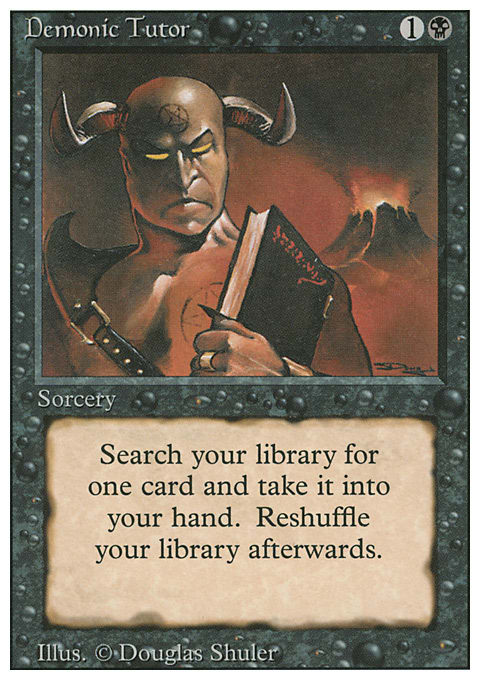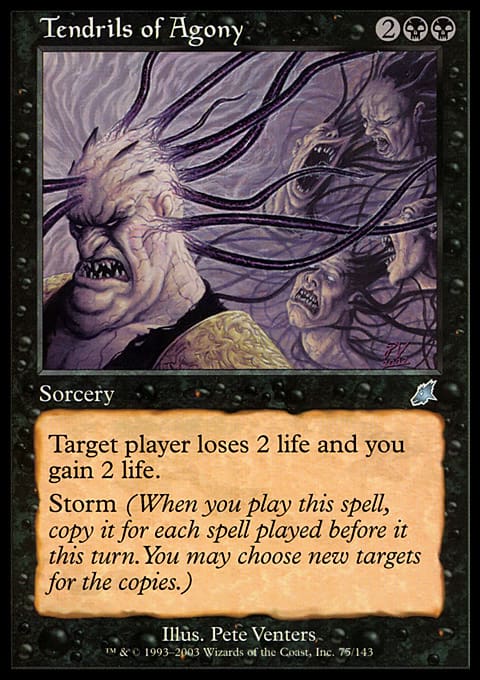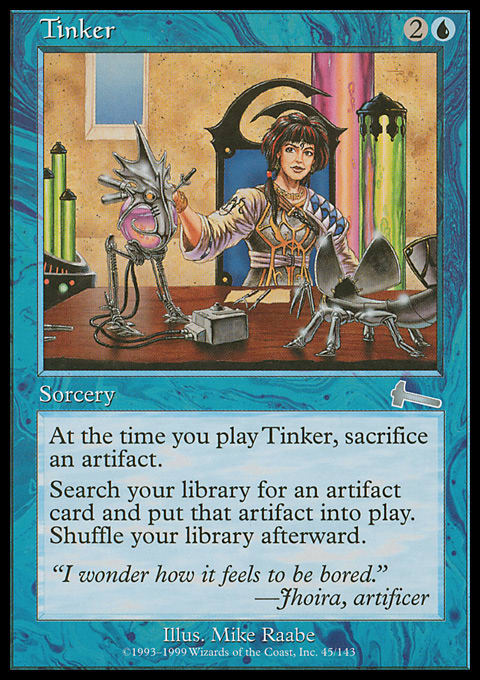Vintage Magic: The Gathering is very much defined by the restricted list, a collection of cards that have shown themselves to be too powerful or dominating for the format to handle as four-ofs. Most restricted cards aren’t consistent enough to build entire decks around by themselves—win conditions like Time Vault and Tinker being the exceptions to that rule—but they find their way into most decks, where they play a critical role in how those decks perform.
Other writers and I have looked before at why cards are restricted. These discussions usually come up around set releases, in conjunction with banned-and-restricted list changes, as Vintage writers and readers love to speculate on what cards will be added or removed from the list. It’s useful, however, to consider what restriction does to certain cards.
In younger formats, playing cards in a certain number can be a very deliberate decision, depending on when and how often you want to see a card or effect. Those decisions can be limited in Vintage, but including or excluding a particular restricted card, and how you use it in game, are still very important when it comes to winning or losing.
In many cases, restricted cards act as play sets of slightly different cards. Consider a group like Demonic Tutor, Vampiric Tutor, Mystical Tutor, and Tinker, for example; in one way or another, they can all find Time Vault (Mystical Tutor by searching for Tinker). Switch Merchant Scroll in for Tinker, and that group can serve as an answering machine, searching up a one-of Hurkyl's Recall when death by Blightsteel Colossus is on the line, and reducing the number of necessary main-decked copies. They may also search for Ancestral Recall as part of a card-advantage engine to stay ahead or keep up with an opponent. The restricted foursome of Ancestral Recall, Brainstorm, Ponder, and Treasure Cruise frequently augments another draw engine (Preordain, Gush, or Thirst for Knowledge) and helps tie things together.
Blue Vintage decks play all of these cards together, leading to the criticism that Vintage decks are all or mostly the same. Frankly, there’s some legitimacy to that, but there are still plenty of different strategies and tactics to use. Blue Vintage decks include all the colors and span the range from control to combo. They start with a similar set of cards because—just as in other formats—players want to use the best cards available to them. Wizards has conveniently put those cards into a list, giving players somewhere to start.
Left and Right Hands of the Devil
For a long time, Trinisphere was the only restricted card not from the Power Nine that Mishra's Workshop decks played. Now Chalice of the Void has joined it. Restricted cards in Workshop decks are an interesting conundrum. Most lock pieces, and especially Trinisphere and Chalice, are best in the early game, but Workshops don’t usually have a draw or tutor engine to find them.
On turn one, Trinisphere can be absolutely crushing, sometimes game-winning on its own. It shuts off Moxes and Force of Will during critical turns, it makes cantrips untenable, and it slows the game to a crawl. Plus, Workshops can play through it with its namesake card and its mana base. So why not include it? Trinisphere actually becomes worse as the game goes on. First, that’s because the opponent will have more mana in play, and second, it’s because other Sphere of Resistance effects build up, making its effect redundant. There have even been some decks that skip Trinisphere altogether since drawing it in the midgame or late game can see it essentially as a dead card.
Now I wonder if Chalice of the Void will find a similar fate. It is powerful turn one when it can shut off opposing Moxes or, against some decks, shut off a cantrip draw engine based on Preordains and other 1-drops. Unlike Trinisphere, though, Chalice scales, and it can be used in a more targeted role in the later games to shut off the cards that beat ’Shops, cards like Hurkyl's Recall, Oath of Druids, and Tinker. Slow down the game with Sphere effects, buy time to find Chalice, and then shut off your opponent’s endgame. For Chalice, it’s a different strategy from how it was used before, but it maintains its utility better throughout the game.
Restricted Chalice of the Void may also mean that Workshop decks are more able to use their own Moxes rather than locking them out on turn one. Because artifact acceleration is so important to the rest of the format, though, I think we will see more Workshop decks playing Null Rod to compensate. Any Workshop decks that can’t run Null Rod (perhaps because it’s playing Kuldotha Forgemaster or Equipment) may be encouraged to run additional artifact sources like Mox Opal, however. We’ll see how true this prediction holds as the format settles more.
Grave Matters
One question that’s come up recently for me has been the interactions of the newly restricted delve spells Dig Through Time and Treasure Cruise, with perennial graveyard-based game dominator Yawgmoth's Will and its buddies Snapcaster Mage and Jace, Telepath Unbound. I’ve been playing Yawgmoth's Will and delve spells together for almost a year, and though they can collide at times, the inherent power of playing all three cards is worthwhile. Currently, I have this list together, based on my earlier one:
Gush Storm ? Vintage | Nat Moes
- Creatures (4)
- 1 Blightsteel Colossus
- 3 Jace, Vryn's Prodigy
- Spells (42)
- 1 Ancestral Recall
- 1 Brainstorm
- 1 Dig Through Time
- 1 Gifts Ungiven
- 1 Hurkyl's Recall
- 1 Misdirection
- 1 Mystical Tutor
- 1 Vampiric Tutor
- 2 Flusterstorm
- 4 Force of Will
- 4 Gush
- 1 Demonic Tutor
- 1 Merchant Scroll
- 1 Ponder
- 1 Tendrils of Agony
- 1 Time Walk
- 1 Tinker
- 1 Treasure Cruise
- 1 Yawgmoth's Will
- 3 Thoughtseize
- 4 Preordain
- 1 Fastbond
- 1 Black Lotus
- 1 Lotus Petal
- 1 Mana Crypt
- 1 Mox Emerald
- 1 Mox Jet
- 1 Mox Sapphire
- 1 Time Vault
- 1 Voltaic Key
- Lands (14)
- 2 Island
- 2 Tropical Island
- 3 Polluted Delta
- 3 Underground Sea
- 4 Misty Rainforest
- Sideboard (15)
- 1 Forest
- 1 Yixlid Jailer
- 1 Pithing Needle
- 1 Toxic Deluge
- 1 Tormod's Crypt
- 1 Surgical Extraction
- 2 Hurkyl's Recall
- 2 Mindbreak Trap
- 2 Ravenous Trap
- 3 Nature's Claim
This deck has three strong routes to victory in Time Vault, Tinker, and Tendrils of Agony, so many of the in-game decisions are made on the fly, based on the situation. Typically, I try to think about an upcoming plan and leave effects in my graveyard rather than particular cards: draw spells, protection, tutors, mana, and bombs. This also means thinking of how much of a particular effect is in the deck, so lands and cantrips like Preordain hold less value than most restricted cards.
Consider cost-to-effect ratio, too. From there, you can rate cards within a category, leaving Ancestral Recall over Brainstorm and Brainstorm over Preordain, for example. Or if you’re forced to choose between Demonic Tutor and Vampiric Tutor, consider how limited you’ll be on mana and draw spells. Based on all this, certain cards will almost never be removed; Black Lotus, Ancestral Recall, and Time Walk only are delved away in the most dire situations.
Thankfully, many of the early-game cards in this type of deck are easy to delve away and not look back. After a turn or two of setup with fetch lands, Thoughtseize, Preordain, and a counterspell, for example, you can usually delve the whole ’yard and worry about missing something later. The effect of either Digging through seven cards or Cruising through three is almost always going to be worth it.
If you have a larger graveyard and are trying to setup Yawgmoth's Will specifically, there are a few more things to keep in mind once you’ve gotten rid of the first few obvious choices. First, unless Fastbond is part of the equation, you’ll only need one land, and you could find that from a Gush. Second, cards like Regrowth and Gifts Ungiven lose some of their luster; Regrowth is usually redundant with Will, and Gifts is not only relatively expensive, but is also risky since it will get rid of half the cards tutored for permanently.
So, last, as I mentioned, it helps to have a plan. Maybe you want Gifts Ungiven. And cards like Hurkyl's Recall can be easy to pitch to Jace or other effects, but they can be very effective for building storm when going for Tendrils. Tinker is often easier to set up, but you might want to save a Thoughtseize to play or be able to tutor for Misdirection to protect Blightsteel Colossus from bounce or Time Vault from Abrupt Decay.
Hot for Tutor
A few weeks ago, I put a poll up on Twitter:
Search your library for a blue instant card, reveal that card, and put it into your hand #inVintage
— Grandpa Belcher (@GrandpaBelcher) November 4, 2015
Taking into account the limitations of the Twitter format (contextless and binary), I like these polls. And for the most part, I agree with the responders: Most of the time, tutors (in this case, I referred indirectly to Merchant Scroll) are better used to advance your own plan (Ancestral Recall) than to stop your opponent (Force of Will). Tutors are an important part of a blue Vintage deck (or even in Workshops, now with Kuldotha Forgemaster), so it’s important to use them to their maximum advantage.
There are many times when tutoring for a bomb will just win the game and when tutoring for an answer will only not lose it. If you’re worried about losing and you could tutor for a simple answer, like Toxic Deluge to take out of a horde of Monks, consider what grabbing a card like Tinker or Gifts Ungiven or Yawgmoth's Will would do in the same situation. Can you set up a win rather than merely try to stabilize? Your deck has some of the most powerful cards in Magic, which you chose specifically for their ability to win games. That also means finding Force of Will or other protection if you need to make sure your bombs resolve.
I’ve previously recounted an experience of mine a few years ago when I played to “not lose” rather than to win. Instead of setting up a Merchant Scroll for Mystical Tutor for Yawgmoth's Will tutor chain, I Merchant Scroll’d for Repeal to stop a Tinker robot. It cost me the game and the match, in Top 4. It was a moment of foolish weakness. When you have an opportunity to win the game, go ahead and take it. With Demonic Tutor, Vampiric Tutor, Mystical Tutor, and Merchant Scroll in the main deck, there are always options.
Speaking of . . . the value of Merchant Scroll has gone up considerably with the printing of Flusterstorm and Dig Through Time. Now Scroll has uses throughout the game in many situations. The primary use has always been Ancestral Recall as a quick way to move through the deck and pull ahead on cards, but there are great bombs (Gifts Ungiven, Mystical Tutor, Dig Through Time), draw (Gush, Thirst for Knowledge), and answers (Force of Will, Misdirection, Flusterstorm, and Hurkyl's Recall). Being able to set up big plays by finding a bomb or protection means that Scroll is going to become harder to cut from blue-based decks without good reason.
Improving in Vintage is a matter of practice and repetition, as it is in other formats, and much of that practice necessarily comes in effectively and creatively using the restricted list. It takes forethought, starting in deck construction, not only to set up your own plays, but also to anticipate and parry your opponent’s reactions. And it takes creativity to recognize opportunities to apply cards in new and exciting ways. I highly recommend experimenting with some Vintage decks and cards on your own. Who knows what you’ll come up with?
Thanks for reading!
Nat Moes



























